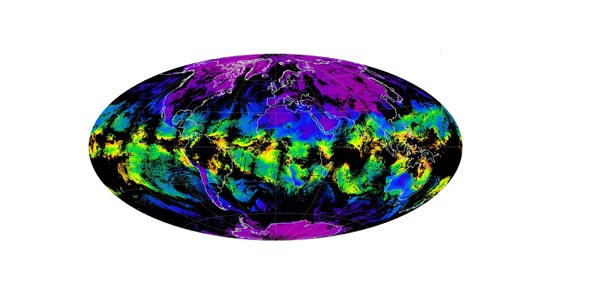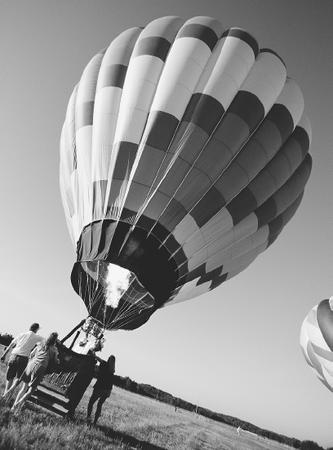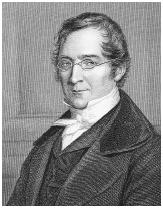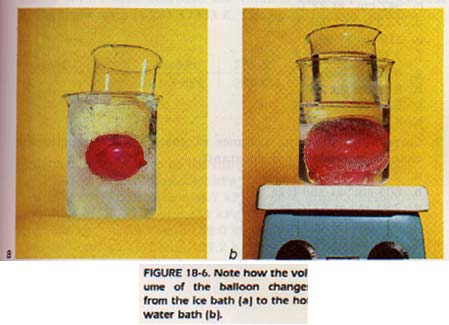Chpt. 4 - Section A: Gases In The Atmosphere

Chapter 4, Section A: Gases in the Atmosphere
- 1.
This gas is the most abundant in the atmosphere.
- A.
Nitrogen
- B.
Hydrogen
- C.
Oxygen
- D.
Argon
Correct Answer
A. NitrogenExplanation
Hydrogen is very rare in the atmosphere.
Oxygen only makes up 20%
Argon is only about 1% of the atmosphereRate this question:
-
- 2.
Air is best described as...
- A.
Pure substance
- B.
Compound
- C.
Element
- D.
Solution
Correct Answer
D. SolutionExplanation
Air is a homogeneous mixture, also called a solutionRate this question:
-
- 3.
You have 1.42 L of a gas exerting a pressure of 125 kPA. Assuming constant temperature what pressure will the gas exert if its volume is reduced to 0.853L? (Boyle's Law: P1V1 = P2V2)
- A.
75.1 kPA
- B.
208 kPA
- C.
151 kPA
- D.
More information is needed
Correct Answer
B. 208 kPAExplanation
A: do you think the volume increasing or decreasing?
C: try using the 'reason and ration' method.
D: check your math.Rate this question:
-
- 4.
Which of the following terms best describes the relationship between pressure and volume? (Boyle's Law)
- A.
Inversely related
- B.
Directly related
- C.
Complimentary
- D.
Indirectly related
Correct Answer
A. Inversely relatedExplanation
Boyle's Law states that the pressure and volume of a gas are inversely related when temperature is held constant. This means that as the volume of a gas increases, the pressure decreases, and vice versa. This relationship can be explained by the behavior of gas molecules. When the volume of a gas is decreased, the molecules are forced closer together, resulting in more frequent collisions with the container walls and an increase in pressure. Conversely, when the volume is increased, the molecules have more space to move around, leading to fewer collisions and a decrease in pressure. Therefore, "inversely related" is the best term to describe the relationship between pressure and volume in Boyle's Law.Rate this question:
-
- 5.
Which of the following terms best describes the relationship between temperature and volume?
- A.
Inversely related
- B.
Directly related
- C.
Complimentary
- D.
Indirectly related
Correct Answer
B. Directly relatedExplanation
The term "directly related" best describes the relationship between temperature and volume. This means that as temperature increases, the volume also increases, and as temperature decreases, the volume decreases. The two variables change in the same direction, indicating a positive correlation between them.Rate this question:
-
- 6.
A temperature of 373 K is equal to what temperature on the Celsius scale?
- A.
0 degrees Celsius
- B.
100 degrees Celsius
- C.
373 degrees Celsius
- D.
646 degrees Celsius
Correct Answer
B. 100 degrees CelsiusExplanation
A: 0 degrees is the freezing point of water
C & D: is Celsius plus 273 = kelvinRate this question:
-
- 7.
What causes pressure inside a tire?
- A.
Gas molecules colliding with each other
- B.
Gas molecules colliding with the wall of the tire
- C.
The diffusion of the gases
- D.
Constant changing of temperature
Correct Answer
B. Gas molecules colliding with the wall of the tireExplanation
The pressure inside a tire is caused by gas molecules colliding with the wall of the tire. As the gas molecules move around inside the tire, they collide with the walls, exerting a force. This force creates pressure, which is measured in pounds per square inch (psi). The more collisions that occur, the higher the pressure inside the tire.Rate this question:
-
- 8.
A sample of oxygen occupies 400mL when the pressure is 800mm Hg. If the temperature is held constant, what is the volume that the gas will occupy if the pressure decreases to 400mm Hg? (Boyle's Law: P1V1 = P2V2)
- A.
200mL
- B.
800mL
- C.
1600mL
- D.
2400mL
Correct Answer
B. 800mLExplanation
According to Boyle's Law, the product of pressure and volume is constant when temperature is held constant. In this case, the initial pressure is 800mm Hg and the initial volume is 400mL. The final pressure is 400mm Hg. To find the final volume, we can rearrange Boyle's Law equation as P1V1 = P2V2 and solve for V2. Plugging in the given values, we get (800mm Hg)(400mL) = (400mm Hg)(V2). Solving for V2, we find that the final volume is 800mL.Rate this question:
-
- 9.
To pop popcorn, you need to increase the temperature, which causes an increase in
- A.
The pressure of the water vapor inside the popcorn kernels
- B.
The volume of the liquid water inside the popcorn kernels
- C.
The mass of the water vapor inside the popcorn kernels
- D.
The solubility of the water vapor inside the popcorn kernels
Correct Answer
A. The pressure of the water vapor inside the popcorn kernelsExplanation
When popcorn is heated, the water inside the kernels turns into steam. This steam builds up pressure within the kernel, causing it to eventually explode and turn into popcorn. Therefore, increasing the temperature increases the pressure of the water vapor inside the popcorn kernels.Rate this question:
-
- 10.
A gas is collected at 600. mm Hg and 300. K. What would the pressure be at 350 K (at constant volume)? (Gay Lussac's Law: P1/T1 = P2/T2)
- A.
175 mm Hg
- B.
300. mm Hg
- C.
514 mm Hg
- D.
700. mm Hg
Correct Answer
D. 700. mm HgExplanation
According to Gay Lussac's Law, the pressure of a gas is directly proportional to its temperature when the volume is constant. In this case, the initial pressure is 600 mm Hg at a temperature of 300 K. To find the pressure at 350 K, we can use the formula P1/T1 = P2/T2. Plugging in the values, we get P2 = (P1 * T2) / T1 = (600 * 350) / 300 = 700 mm Hg. Therefore, the correct answer is 700 mm Hg.Rate this question:
-
- 11.
A gas has a pressure of 801 mm Hg at 349 K. If the pressure is reduced to 701 mm Hg, what is the new temperature? (Gay Lussac's Law: P1/T1 = P2/T2)
- A.
250 K
- B.
305 K
- C.
399 K
- D.
802 K
Correct Answer
B. 305 KExplanation
According to Gay Lussac's Law, the pressure and temperature of a gas are directly proportional. Therefore, if the pressure is reduced from 801 mm Hg to 701 mm Hg, the temperature should also decrease. The correct answer is 305 K, which is lower than the initial temperature of 349 K.Rate this question:
-
- 12.
Calculate the pressure in kilopascals exerted by a textbook on the desk. The dimensions of the textbook are 24.0 cm by 18.0 cm and the force it exerts is 3.00 Newtons. (Pressure = Force/Area)
- A.
69.4 kPa
- B.
0.0694 kPa
- C.
0.0144 kPa
- D.
14.4 kPa
Correct Answer
B. 0.0694 kPaExplanation
The pressure exerted by the textbook on the desk can be calculated by dividing the force exerted by the area over which it is distributed. The area can be found by multiplying the length and width of the textbook. In this case, the area is (24.0 cm)(18.0 cm) = 432.0 cm². Converting the force to Newtons, the pressure is then calculated as 3.00 N / 432.0 cm² = 0.00694 N/cm². To convert this to kilopascals, we divide by 1000, resulting in 0.00694 kPa. Rounding to four decimal places, the answer is 0.0694 kPa.Rate this question:
-
- 13.
If temperature is held constant, decreasing the volume of a sample of gas will cause its pressure to..
- A.
Decrease
- B.
Increase
- C.
Remain the same
Correct Answer
B. IncreaseExplanation
according to Boyle's Law, volume is inverse to pressure. Decreasing the volume will increase the pressure.Rate this question:
-
- 14.
In the relationship described by Boyle's law, which property must remain constant?
- A.
Pressure
- B.
Temperature
- C.
Volume
Correct Answer
B. TemperatureExplanation
Boyle's law states that the pressure of a gas is inversely proportional to its volume, as long as the temperature remains constant. This means that if the volume of a gas decreases, its pressure will increase, and vice versa. Therefore, in the relationship described by Boyle's law, the property that must remain constant is temperature. Any changes in temperature would affect the relationship between pressure and volume, violating Boyle's law.Rate this question:
-
- 15.
When air is removed from a bell jar with a vacuum pump reducing the pressure in the bell jar (at constant temperature), a sealed inflated balloon inside the bell jar
- A.
Gets smaller
- B.
Gets larger
- C.
Stays the same size
Correct Answer
B. Gets largerExplanation
When air is removed from a bell jar with a vacuum pump, the pressure inside the bell jar decreases. As a result, the pressure inside the inflated balloon becomes higher than the pressure outside. This pressure difference causes the balloon to expand and get larger in size.Rate this question:
-
- 16.
In the relationship described by Charles' Law, which property must remain constant?
- A.
Pressure
- B.
Temperature
- C.
Volume
Correct Answer
A. PressureExplanation
In Charles' Law, the relationship between temperature and volume of a gas at constant pressure is described. According to this law, when the temperature of a gas increases, its volume also increases, and vice versa, as long as the pressure remains constant. Therefore, in order to maintain the relationship described by Charles' Law, the property that must remain constant is pressure.Rate this question:
-
Quiz Review Timeline +
Our quizzes are rigorously reviewed, monitored and continuously updated by our expert board to maintain accuracy, relevance, and timeliness.
-
Current Version
-
Mar 20, 2022Quiz Edited by
ProProfs Editorial Team -
Feb 03, 2008Quiz Created by
Sgreenblatt
- Air Quizzes
- Beach Quizzes
- Biome Quizzes
- Climate Quizzes
- Conservation Quizzes
- Desert Quizzes
- Diffusion Quizzes
- Disaster Quizzes
- Ecosystem Quizzes
- Evolution Quizzes
- Fire Quizzes
- Flower Quizzes
- Forest Quizzes
- Global Warming Quizzes
- Lake Quizzes
- Landform Quizzes
- Mountain Quizzes
- Natural Resource Quizzes
- Nature Of Matter Quizzes
- Osmosis Quizzes
- Plant Quizzes
- Pollution Quizzes
- Recycling Quizzes
- River Quizzes
- Sea Quizzes
- Season Quizzes
- Snow Quizzes
- Soil Quizzes
- Water Quizzes
- Weather Quizzes
- Wildlife Quizzes
- Wind Quizzes
 Back to top
Back to top

















